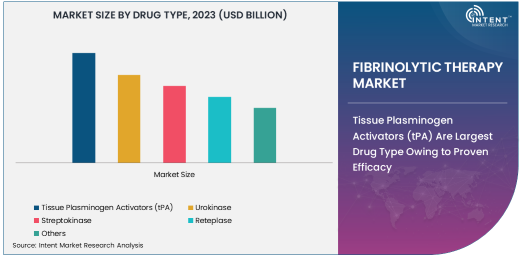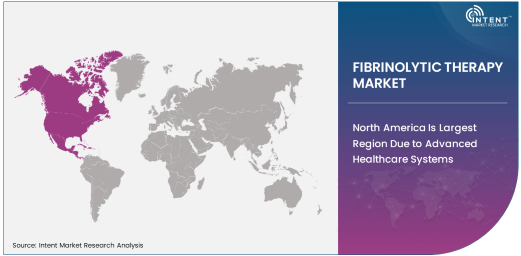As per Intent Market Research, the Fibrinolytic Therapy Market was valued at USD 2.0 Billion in 2023 and will surpass USD 3.6 Billion by 2030; growing at a CAGR of 8.7% during 2024 - 2030.
The fibrinolytic therapy market is witnessing steady growth, driven by the increasing prevalence of thrombotic disorders and advancements in therapeutic techniques. Fibrinolytic drugs play a crucial role in dissolving blood clots and restoring normal blood flow, making them indispensable in managing life-threatening conditions like myocardial infarction, stroke, and pulmonary embolism. This report explores the market's key segments, identifying the largest or fastest-growing subsegments across drug types, applications, and end-use industries, alongside a regional analysis and a brief overview of the competitive landscape.
Tissue Plasminogen Activators (tPA) Are Largest Drug Type Owing to Proven Efficacy
Tissue plasminogen activators (tPA) dominate the drug type segment, thanks to their established role in emergency thrombolytic treatments, particularly for acute ischemic stroke and myocardial infarction. These biologically derived drugs efficiently activate plasminogen to dissolve fibrin clots, significantly reducing mortality and morbidity rates.
The widespread adoption of tPA is bolstered by its inclusion in critical care protocols and endorsements from global health organizations. Continued advancements in recombinant DNA technology have also enhanced the availability and efficacy of tPA formulations, further solidifying its market dominance.

Stroke Management Is Fastest Growing Application Due to Rising Incidence
Stroke management is the fastest-growing application segment in the fibrinolytic therapy market. The increasing global burden of stroke, fueled by aging populations and lifestyle-related risk factors, has heightened demand for effective clot-dissolving therapies. Fibrinolytic drugs, particularly tPA, are a cornerstone in acute ischemic stroke treatment, offering time-sensitive solutions that minimize long-term disability.
Governments and healthcare organizations worldwide are prioritizing stroke management through awareness campaigns and better emergency care infrastructure, driving the adoption of fibrinolytic therapies. As early diagnosis and intervention rates improve, this segment is poised for rapid growth.
Hospitals Are Largest End-Use Industry Owing to Comprehensive Care Capabilities
Hospitals represent the largest end-use industry for fibrinolytic therapy, attributed to their ability to provide comprehensive care, including emergency thrombolytic treatments. With advanced diagnostic tools and specialized critical care units, hospitals are the primary point of care for patients requiring fibrinolytic drugs.
The growing number of healthcare facilities equipped to administer these therapies and the rising prevalence of thrombotic disorders ensure that hospitals will continue to dominate this segment. Their central role in managing acute conditions like myocardial infarction and stroke reinforces their significance in the fibrinolytic therapy market.
North America Is Largest Region Due to Advanced Healthcare Systems
North America holds the largest share in the fibrinolytic therapy market, driven by a well-established healthcare infrastructure and high awareness of thrombolytic treatments. The region benefits from favorable reimbursement policies and a strong presence of key market players, facilitating widespread access to fibrinolytic drugs.
The United States leads this regional market, with increasing investments in stroke and cardiac care programs. The robust adoption of advanced therapeutics and a growing focus on reducing cardiovascular disease mortality rates further enhance North America's market position.

Competitive Landscape and Leading Companies
The fibrinolytic therapy market is competitive, with leading players focusing on innovation, strategic collaborations, and geographic expansion. Key companies include Genentech (a member of Roche Group), Boehringer Ingelheim, and Grifols, known for their extensive product portfolios and cutting-edge research in thrombolytic therapies.
These players are investing in next-generation fibrinolytic drugs with improved efficacy and reduced side effects. The competitive landscape is also shaped by collaborations with healthcare providers and participation in public health initiatives aimed at improving access to thrombolytic treatments. As demand for fibrinolytic therapies continues to rise, market participants are expected to prioritize technological advancements and expansion into emerging markets.
Recent Developments:
- Genentech (Roche Group) launched an advanced tissue plasminogen activator (tPA) with enhanced efficacy for acute ischemic stroke patients.
- Boehringer Ingelheim received regulatory approval for its novel thrombolytic agent targeting deep vein thrombosis.
- Pfizer Inc. announced a collaboration with a biotech firm to develop next-generation fibrinolytic therapies.
- Sanofi introduced a biosimilar urokinase drug targeting underserved markets in Asia-Pacific.
- Novartis AG expanded its portfolio by acquiring a fibrinolytic drug developer specializing in rare clotting disorders.
List of Leading Companies:
- AbbVie Inc.
- Amgen Inc.
- Bayer AG
- Boehringer Ingelheim
- CSL Behring
- Genentech, Inc. (Roche Group)
- Grifols S.A.
- Johnson & Johnson
- LFB Group
- Mylan N.V.
- Novartis AG
- Pfizer Inc.
- Sanofi
- Takeda Pharmaceutical Company
- Teva Pharmaceuticals Industries Ltd.
Report Scope:
|
Report Features |
Description |
|
Market Size (2023) |
USD 2.0 Billion |
|
Forecasted Value (2030) |
USD 3.6 Billion |
|
CAGR (2024 – 2030) |
8.7% |
|
Base Year for Estimation |
2023 |
|
Historic Year |
2022 |
|
Forecast Period |
2024 – 2030 |
|
Report Coverage |
Market Forecast, Market Dynamics, Competitive Landscape, Recent Developments |
|
Segments Covered |
Fibrinolytic Therapy Market by Drug Type (Tissue Plasminogen Activators (tPA), Urokinase, Streptokinase, Reteplase), by Application (Acute Myocardial Infarction (AMI), Deep Vein Thrombosis (DVT), Pulmonary Embolism, Stroke Management), by End-Use Industry (Hospitals, Specialty Clinics, Ambulatory Surgical Centers) |
|
Regional Analysis |
North America (US, Canada, Mexico), Europe (Germany, France, UK, Italy, Spain, and Rest of Europe), Asia-Pacific (China, Japan, South Korea, Australia, India, and Rest of Asia-Pacific), Latin America (Brazil, Argentina, and Rest of Latin America), Middle East & Africa (Saudi Arabia, UAE, Rest of Middle East & Africa) |
|
Major Companies |
AbbVie Inc., Amgen Inc., Bayer AG, Boehringer Ingelheim, CSL Behring, Genentech, Inc. (Roche Group), Johnson & Johnson, LFB Group, Mylan N.V., Novartis AG, Pfizer Inc., Sanofi, Teva Pharmaceuticals Industries Ltd. |
|
Customization Scope |
Customization for segments, region/country-level will be provided. Moreover, additional customization can be done based on the requirements |
|
1. Introduction |
|
1.1. Market Definition |
|
1.2. Scope of the Study |
|
1.3. Research Assumptions |
|
1.4. Study Limitations |
|
2. Research Methodology |
|
2.1. Research Approach |
|
2.1.1. Top-Down Method |
|
2.1.2. Bottom-Up Method |
|
2.1.3. Factor Impact Analysis |
|
2.2. Insights & Data Collection Process |
|
2.2.1. Secondary Research |
|
2.2.2. Primary Research |
|
2.3. Data Mining Process |
|
2.3.1. Data Analysis |
|
2.3.2. Data Validation and Revalidation |
|
2.3.3. Data Triangulation |
|
3. Executive Summary |
|
3.1. Major Markets & Segments |
|
3.2. Highest Growing Regions and Respective Countries |
|
3.3. Impact of Growth Drivers & Inhibitors |
|
3.4. Regulatory Overview by Country |
|
4. Fibrinolytic Therapy Market, by Drug Type (Market Size & Forecast: USD Million, 2022 – 2030) |
|
4.1. Tissue Plasminogen Activators (tPA) |
|
4.2. Urokinase |
|
4.3. Streptokinase |
|
4.4. Reteplase |
|
4.5. Others |
|
5. Fibrinolytic Therapy Market, by Application (Market Size & Forecast: USD Million, 2022 – 2030) |
|
5.1. Acute Myocardial Infarction (AMI) |
|
5.2. Deep Vein Thrombosis (DVT) |
|
5.3. Pulmonary Embolism |
|
5.4. Stroke Management |
|
5.5. Others |
|
6. Fibrinolytic Therapy Market, by End-Use Industry (Market Size & Forecast: USD Million, 2022 – 2030) |
|
6.1. Hospitals |
|
6.2. Specialty Clinics |
|
6.3. Ambulatory Surgical Centers |
|
6.4. Others |
|
7. Regional Analysis (Market Size & Forecast: USD Million, 2022 – 2030) |
|
7.1. Regional Overview |
|
7.2. North America |
|
7.2.1. Regional Trends & Growth Drivers |
|
7.2.2. Barriers & Challenges |
|
7.2.3. Opportunities |
|
7.2.4. Factor Impact Analysis |
|
7.2.5. Technology Trends |
|
7.2.6. North America Fibrinolytic Therapy Market, by Drug Type |
|
7.2.7. North America Fibrinolytic Therapy Market, by Application |
|
7.2.8. North America Fibrinolytic Therapy Market, by End-Use Industry |
|
7.2.9. By Country |
|
7.2.9.1. US |
|
7.2.9.1.1. US Fibrinolytic Therapy Market, by Drug Type |
|
7.2.9.1.2. US Fibrinolytic Therapy Market, by Application |
|
7.2.9.1.3. US Fibrinolytic Therapy Market, by End-Use Industry |
|
7.2.9.2. Canada |
|
7.2.9.3. Mexico |
|
*Similar segmentation will be provided for each region and country |
|
7.3. Europe |
|
7.4. Asia-Pacific |
|
7.5. Latin America |
|
7.6. Middle East & Africa |
|
8. Competitive Landscape |
|
8.1. Overview of the Key Players |
|
8.2. Competitive Ecosystem |
|
8.2.1. Level of Fragmentation |
|
8.2.2. Market Consolidation |
|
8.2.3. Product Innovation |
|
8.3. Company Share Analysis |
|
8.4. Company Benchmarking Matrix |
|
8.4.1. Strategic Overview |
|
8.4.2. Product Innovations |
|
8.5. Start-up Ecosystem |
|
8.6. Strategic Competitive Insights/ Customer Imperatives |
|
8.7. ESG Matrix/ Sustainability Matrix |
|
8.8. Manufacturing Network |
|
8.8.1. Locations |
|
8.8.2. Supply Chain and Logistics |
|
8.8.3. Product Flexibility/Customization |
|
8.8.4. Digital Transformation and Connectivity |
|
8.8.5. Environmental and Regulatory Compliance |
|
8.9. Technology Readiness Level Matrix |
|
8.10. Technology Maturity Curve |
|
8.11. Buying Criteria |
|
9. Company Profiles |
|
9.1. AbbVie Inc. |
|
9.1.1. Company Overview |
|
9.1.2. Company Financials |
|
9.1.3. Product/Service Portfolio |
|
9.1.4. Recent Developments |
|
9.1.5. IMR Analysis |
|
*Similar information will be provided for other companies |
|
9.2. Amgen Inc. |
|
9.3. Bayer AG |
|
9.4. Boehringer Ingelheim |
|
9.5. CSL Behring |
|
9.6. Genentech, Inc. (Roche Group) |
|
9.7. Grifols S.A. |
|
9.8. Johnson & Johnson |
|
9.9. LFB Group |
|
9.10. Mylan N.V. |
|
9.11. Novartis AG |
|
9.12. Pfizer Inc. |
|
9.13. Sanofi |
|
9.14. Takeda Pharmaceutical Company |
|
9.15. Teva Pharmaceuticals Industries Ltd. |
|
10. Appendix |
A comprehensive market research approach was employed to gather and analyze data on the Fibrinolytic Therapy Market. In the process, the analysis was also done to analyze the parent market and relevant adjacencies to measure the impact of them on the Fibrinolytic Therapy Market. The research methodology encompassed both secondary and primary research techniques, ensuring the accuracy and credibility of the findings.
.jpg)
Secondary Research
Secondary research involved a thorough review of pertinent industry reports, journals, articles, and publications. Additionally, annual reports, press releases, and investor presentations of industry players were scrutinized to gain insights into their market positioning and strategies.
Primary Research
Primary research involved conducting in-depth interviews with industry experts, stakeholders, and market participants across the E-Waste Management ecosystem. The primary research objectives included:
- Validating findings and assumptions derived from secondary research
- Gathering qualitative and quantitative data on market trends, drivers, and challenges
- Understanding the demand-side dynamics, encompassing end-users, component manufacturers, facility providers, and service providers
- Assessing the supply-side landscape, including technological advancements and recent developments
Market Size Assessment
A combination of top-down and bottom-up approaches was utilized to analyze the overall size of the Fibrinolytic Therapy Market. These methods were also employed to assess the size of various subsegments within the market. The market size assessment methodology encompassed the following steps:
- Identification of key industry players and relevant revenues through extensive secondary research
- Determination of the industry's supply chain and market size, in terms of value, through primary and secondary research processes
- Calculation of percentage shares, splits, and breakdowns using secondary sources and verification through primary sources
.jpg)
Data Triangulation
To ensure the accuracy and reliability of the market size, data triangulation was implemented. This involved cross-referencing data from various sources, including demand and supply side factors, market trends, and expert opinions. Additionally, top-down and bottom-up approaches were employed to validate the market size assessment.
NA
